

  |
|
 | |
 War! War!! So read The Scottsville Register's headlines on Saturday,
April 20, 1861. Three days earlier in Richmond, the Virginia State Convention adopted an
ordinance of secession from the Union. That evening the Scottsville Guard, a militia unit
commanded by Captain Henry Gantt, received a telegram ordering them to arms. Their immediate
assignment was to board a Charlottesville train destined to capture the weapons and storage arsenal
in Harpers Ferry. Although Gantt's unit could not reach Charlottesville in time, his men
began drilling on Scottsville streets. By Saturday, the Howardsville Blues joined the
Scottsville Guard, forming two companies of the 19th Regiment of Virginia Infantry.
War! War!! So read The Scottsville Register's headlines on Saturday,
April 20, 1861. Three days earlier in Richmond, the Virginia State Convention adopted an
ordinance of secession from the Union. That evening the Scottsville Guard, a militia unit
commanded by Captain Henry Gantt, received a telegram ordering them to arms. Their immediate
assignment was to board a Charlottesville train destined to capture the weapons and storage arsenal
in Harpers Ferry. Although Gantt's unit could not reach Charlottesville in time, his men
began drilling on Scottsville streets. By Saturday, the Howardsville Blues joined the
Scottsville Guard, forming two companies of the 19th Regiment of Virginia Infantry.Scottsville eagerly donated money to these soldiers, and women produced uniforms, tents, and knapsacks. After days of drilling, these two militia units joined up with their regiment and departed for Manassas in early May 1861. Their departure from Scottsville was accompanied by a tremendous public outpouring of celebration and grief. By June 1861, the call went out for more soldiers to join the Confederate Army. Although pressed to its emotional and physical limits, Scottsville produced another company, called the Scottsville Grays, with the help of a few recruits from neighboring Fluvanna County. The Grays soon became Company D (later Co. E) of the 46th Virginia Infantry and were commanded by Scottsville's Captain James C. Hill, the proprietor of a local lumber company. Hill's company left Scottsville for western Virginia in late June, receiving a more subdued farewell from townspeople, who perhaps realized by then that the war would be long and costly. From Civil War letters and first-hand accounts, we have a fascinating glimpse of Scottsville life during the war. Families and friends of our soldiers occupied themselves with earning a living in a largely agricultural environment with a male work force consisting of boys and old men. Eyes and hearts were always focused on our soldiers on the battlefront. Spare food and clothing were sent to the troops at the front, supplementing the soldiers' meager rations in an army without a well-established supply infrastructure. Many times the food sent to local soldiers meant meals were sparser on Scottsville plates. Still, town thoughts were of its soldiers and aiding the Confederate cause. On the front lines, Scottsville soldiers did their duty and thought of home. Occasionally, soldiers returned to Scottsville on leave or disabled; others returned in coffins. As the war continued, many local boys coming of age ran off to join up with Confederate units such as the 19th VA and 56th VA Infantries. Thirteen young men alone departed Scottsville to join Mosby's Rangers, including the underaged Henry H. Harris and Zach Jones. After four long years of war, the enemy and devastation came to Scottsville. On March 6, 1865, Major General Philip H. Sheridan's expedition of nearly 10,000 Union soldiers departed Charlottesville. Their mission was to destroy the James River Canal and the Virginia Central Railroad. The expedition separated into two columns with Sheridan and Brevet Major General George A. Custer leading the 3rd Cavalry southwest through North and South Gardens to destroy the railroad. Brevet Major General Wesley Merritt and Brigadier General Thomas C. Devin headed south to Scottsville with the 1st Cavalry and orders to destroy the canal, bridges, mills, manufactories, and rebel food stores. 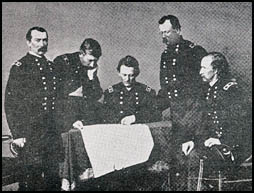 The destruction of Scottsville began at 3 p.m. on that March day, as noted in General Devin's official
report: "At this point, three canal boats were captured, one loaded with shell (9600) and two with
the Government commissary stores and tobacco. These were totally destroyed and burned, together with a
large cloth mill, a five-story flouring mill, candle factory, machine shop, and tobacco warehouse. Each of
these buildings was crammed with products of its manufacture to a surprising extent, and all were
totally destroyed." The intense heat of the flour mill fire charred nearby homes, although no loss
of life occurred. Canal locks and bridges above and below town also were destroyed or severely
damaged. The last of Devin's men departed Scottsville on March 7th and headed west up the towpath
to continue their canal destruction duties and join Sheridan's column at New Market (Norwood).
The destruction of Scottsville began at 3 p.m. on that March day, as noted in General Devin's official
report: "At this point, three canal boats were captured, one loaded with shell (9600) and two with
the Government commissary stores and tobacco. These were totally destroyed and burned, together with a
large cloth mill, a five-story flouring mill, candle factory, machine shop, and tobacco warehouse. Each of
these buildings was crammed with products of its manufacture to a surprising extent, and all were
totally destroyed." The intense heat of the flour mill fire charred nearby homes, although no loss
of life occurred. Canal locks and bridges above and below town also were destroyed or severely
damaged. The last of Devin's men departed Scottsville on March 7th and headed west up the towpath
to continue their canal destruction duties and join Sheridan's column at New Market (Norwood).On March 8th, Sheridan's united command moved back down the James River towards Columbia, arriving in Scottsville on Thursday night, March 9th. The roads were horrible due to the spring thaw and heavy rains, and the soldiers were tired and hungry. Legend has it that Sheridan and Custer rested the night at Cliffside while Merritt commandeered Old Hall. By this stage of the expedition, Sheridan's men were down to their last 'coffee and sugar' rations, and their horses suffered from fatigue and hoof rot. They relied on the Scottsville countryside for 'subsistence and forage' and ransacked and looted homes, barns, and any potential hiding place for food, horses, and valuables. Cliffside's carriage house and barn were torched, although the jewelry, which Mrs. John O. Lewis buried earlier near their chicken house, went undiscovered. Yankees stuffed hams in their knapsacks and strapped dead chickens to their saddles. At age 5, Fannie Patteson stood at a second floor window and watched her backyard fill with strange men, who upset their beehives and crammed honey into their mouths. As the Yankees snatched up every horse they spotted, twelve year-old Luther Pitts hid two local horses in the basement of the Barclay House on Main Street. Miletus Harris and his son, Charles, beat back the flames on their Main Street store as the nearby Columbian Hotel went up in smoke. Finally on March 10th, Sheridan's army departed Scottsville and continued along the James River to Columbia, leaving Scottsville charred and hungry. It would take forty years for the town's economy to recover. To learn more about Scottsville in the Civil War, please click on each image below for a larger view and more information. Also, if you have a story to tell about a Scottsville Civil War soldier, we'd love to learn more. Please contact us at info@scottsvillemuseum.com |
| Dr. Oriana Moon, A Confederate Doctor | ||
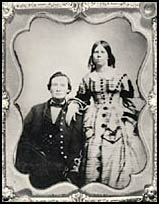 Oriana Moon was an exceptional Scottsville woman, who was awarded a medical degree from the
Female Medical College of Pennsylvania in 1857. She returned briefly to her Viewmont home near Scottsville
and then traveled with her Uncle James Turner Barclay to Jerusalem in 1858. Oriana ministered to the medical needs of the Bedouins, who
lived just outside the Holy City's walls, before returning home to Virginia more than 14 months later. When the Civil
War broke out in 1861, Dr. Moon volunteered her services to the Confederacy and ran a ward at the Charlottesville General Hospital.
It was at this hospital that she met John Summerfield Andrews, a surgeon in the Confederate Army and her future husband-to-be. In November 1861,
Oriana Moon married John Andrews, beginning a marriage and medical collaboration that survived the war and positively affected many people
from Virginia to Alabama.
Oriana Moon was an exceptional Scottsville woman, who was awarded a medical degree from the
Female Medical College of Pennsylvania in 1857. She returned briefly to her Viewmont home near Scottsville
and then traveled with her Uncle James Turner Barclay to Jerusalem in 1858. Oriana ministered to the medical needs of the Bedouins, who
lived just outside the Holy City's walls, before returning home to Virginia more than 14 months later. When the Civil
War broke out in 1861, Dr. Moon volunteered her services to the Confederacy and ran a ward at the Charlottesville General Hospital.
It was at this hospital that she met John Summerfield Andrews, a surgeon in the Confederate Army and her future husband-to-be. In November 1861,
Oriana Moon married John Andrews, beginning a marriage and medical collaboration that survived the war and positively affected many people
from Virginia to Alabama.
For the full feature article, visit Dr. Oriana Moon, A Confederate Doctor. Copyright � 2018 by Scottsville Museum |
||
| A Scottsville Family in Love and War: Mollie Harris | ||
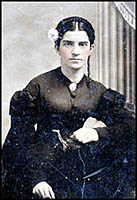 This is the story of a woman who lived in Scottsville 150 years ago. By modern standards she was quite provincial.
She was not beautiful, accomplished, or well traveled, but her life was anything but ordinary. She
lived in a time of national crisis, and she and her family were caught up in the tragedy that rent
the nation. She watched her husband and brothers march off to war and at war's end found
herself a widow with three small children. Further misfortunes were to follow. Tragedy
is so common in the simple annals of the poor that this story would scarcely merit our attention
were it not for the character of Mollie Harris, herself. She possessed unusual resilience and met
adversity with a courage and fortitude that enabled her and her family not only to survive the
hardships of their lives but also to triumph over them.
This is the story of a woman who lived in Scottsville 150 years ago. By modern standards she was quite provincial.
She was not beautiful, accomplished, or well traveled, but her life was anything but ordinary. She
lived in a time of national crisis, and she and her family were caught up in the tragedy that rent
the nation. She watched her husband and brothers march off to war and at war's end found
herself a widow with three small children. Further misfortunes were to follow. Tragedy
is so common in the simple annals of the poor that this story would scarcely merit our attention
were it not for the character of Mollie Harris, herself. She possessed unusual resilience and met
adversity with a courage and fortitude that enabled her and her family not only to survive the
hardships of their lives but also to triumph over them.For the full feature article by Captain Bruce R. Boynton, visit Family in Love and War. Copyright � 2018 by Scottsville Museum |
||
| A Scottsville Teen in Mosby's Rangers: Henry G. Harris | ||
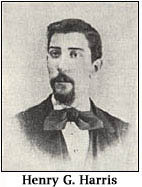 "They had for us all the glamour of Robin Hood and his merry men, all the courage and bravery of
the ancient crusaders, the unexpectedness of benevolent pirates and the stealth of Indians." Thus
wrote Sam Moore, a young man from Berryville, of the fascination held by the people of western
Virginia for Confederate Colonel John S. Mosby's Partisan Rangers (43rd Battalion Virginia Cavalry).
With such a reputation, it is no wonder that Mosby found it easy to attract recruits. The life
of a Ranger, the changing scenes, the danger and wild adventure lured many men to the battalion.
Officers in other units gave up their commissions to enlist as privates. Old soldiers and those
who had been discharged as unfit for further service also joined. Some recruits to the unit were
too young to enlist in the regular Army, while others had been foreign soldiers of fortune.
Among the Battalion's youngest members was a 16-year-old Scottsville boy named Henry G. Harris.
"They had for us all the glamour of Robin Hood and his merry men, all the courage and bravery of
the ancient crusaders, the unexpectedness of benevolent pirates and the stealth of Indians." Thus
wrote Sam Moore, a young man from Berryville, of the fascination held by the people of western
Virginia for Confederate Colonel John S. Mosby's Partisan Rangers (43rd Battalion Virginia Cavalry).
With such a reputation, it is no wonder that Mosby found it easy to attract recruits. The life
of a Ranger, the changing scenes, the danger and wild adventure lured many men to the battalion.
Officers in other units gave up their commissions to enlist as privates. Old soldiers and those
who had been discharged as unfit for further service also joined. Some recruits to the unit were
too young to enlist in the regular Army, while others had been foreign soldiers of fortune.
Among the Battalion's youngest members was a 16-year-old Scottsville boy named Henry G. Harris.For the full feature article by Captain Bruce R. Boynton, visit A Mosby Ranger. Copyright � 2018 by Scottsville Museum |
||
| Captain Roberts Coles: Green Mountain Grays, 46th VA Infantry | ||
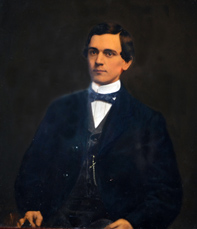 Roberts Coles was the son of Edward Coles, a cousin of Thomas Jefferson whom he urged to publicly work for an end of
slavery in Virginia. When Jefferson declined Coles' request, Edward took his slaves to Pennsylvania where they boarded
two flatboats for a river ride towards Illinois in March 1819. Edward freed his 17 slaves in Illinois and endowed them
with land. He was elected Governor of Illinois for two terms, but was defeated in 1826 by a pro-slavery candidate.
In 1832, Edward moved to Philadelphia where he married Sally Logan Roberts, and they became the parents of Roberts Coles on November
14, 1838.
Roberts Coles was the son of Edward Coles, a cousin of Thomas Jefferson whom he urged to publicly work for an end of
slavery in Virginia. When Jefferson declined Coles' request, Edward took his slaves to Pennsylvania where they boarded
two flatboats for a river ride towards Illinois in March 1819. Edward freed his 17 slaves in Illinois and endowed them
with land. He was elected Governor of Illinois for two terms, but was defeated in 1826 by a pro-slavery candidate.
In 1832, Edward moved to Philadelphia where he married Sally Logan Roberts, and they became the parents of Roberts Coles on November
14, 1838. Despite his northern birth, Roberts thought of himself as a true Virginian. He spent most summers visiting the Coles family in Albemarle County and inherited a piece of property near Enniscorthy. To his father's great disappointment, Roberts Coles returned to Virginia in 1860, where he became a slaveowner and engaged to Jennie Fairfax of Richmond. And then in 1861, the Civil War began in Virginia. To learn more about Roberts Coles in the Civil War, visit Captain Roberts Coles. Copyright � 2018 by Scottsville Museum |
||
| Major J.C. Hill, Soldier of Scottsville | ||
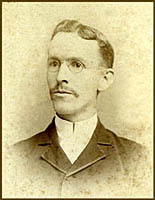 "A good many tents are to be seen on Kiawah Island ... The enemy are burning up the woods to the
North ... There are 2 gunboats, 3 small steamers, 9 schooners ... in the Stono River ... J.C. Hill,
Capt."
"A good many tents are to be seen on Kiawah Island ... The enemy are burning up the woods to the
North ... There are 2 gunboats, 3 small steamers, 9 schooners ... in the Stono River ... J.C. Hill,
Capt."Thus read an 1864 intelligence report, submitted by Captain, later Major, James Christian Hill. Before the War, Hill was a successful businessman of Scottsville; during the War, a caring and effective leader of its men in uniform; and after the War, an honored editor and citizen. For the full feature article by Connie Jo Geary, visit Major J.C. Hill. Copyright � 2018 by Scottsville Museum |
||
| Captain John Thomas Blair, 19th Virginia Infantry | ||
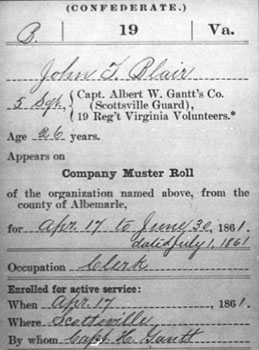 Date: 1861
Date: 1861Image Number: NARA 586957, Roll 0616 Shown at left is the 1861 Company Muster Roll for John Thomas Blair, Captain Albert W. Gantt's Company (Scottsville Guard), 19th Virginia Regiment John was born in Richmond, VA, ca. 1835, the son of John Blair, a physician, and Elizabeth Blair. John Thomas Blair was in Scottsville by 1850 living with his mother and three siblings. As a young man, John went into the commission business and then became a merchant in Scottsville. When Virginia joined the Civil War, John wasted no time in enrolling in the Confederate Army with the Scottsville Guard on 17 April 1861. John was mustered into service in Charlottesville, Virginia, on 11 May 1861. For more information on John Blair's Civil War service and his family, visit John Thomas Blair. Copyright � 2018 by Scottsville Museum |
||
| Captain John B. Anderson, 60th Virginia Infantry | ||
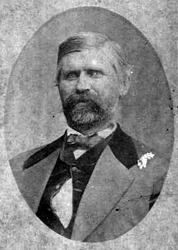 Date: 1862
Date: 1862Image Number: JPW001 John B. Anderson, was a Confederate soldier, who served during the Civil War as a Captain in Company C, 60th Virginia Infantry. Capt. Anderson was born in 1819 and was basically too old (in his 40's) to fight on the Confederate front lines during the war and thus his role reportedly became one focused on finding food for his company's soldiers. After the Civil War, John B. Anderson returned to his family and his 1000-acre farm, which was located on the border of Albemarle and Fluvanna Counties. Like most Southerners after the War, the Anderson family had to start over as the plantation system was extinct. John B. Anderson taught his nine children how to farm and the needed skills of barrel-, broom-, and furniture-making According to the recollections of John B. Anderson's descendants, the family developed an enduring work ethic and how to survive in hard times. For more information on John B. Anderson's Civil War service, and his family, visit Captain John B. Anderson. Copyright � 2022 by Scottsville Museum |
||
| Lieutenant Hopkins Hardin, 19th Virginia Infantry | ||
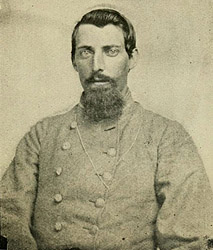 Date: ca. 1862
Date: ca. 1862Image Number: HH01cdHH01 Hopkins Hardin was a Confederate soldier, who served in Company C, 19th Virginia Infantry. At the age of 23, he entered Company C in April 1861, enlisting at Scottsville, Albemarle County, Virginia. He fought in all of the principal battles and skirmishes of his division, taking part in such actions as those at Bull Run (first and second battles), Williamsburg, Fredericksburg, Boonsborough, and, last all, he was in that great decisive battle which determined the fate of the Southern Confederacy, the battle of Gettysburg. In this battle, Hopkins was wounded three times. He had been wounded previously at both Fredericksburg and Boonsborough. There was no question as to his bravery, his ardor, or his enthusiasm in Battle. Young Hopkins Hardin was a dedicated Virginia soldier. For more information on Hopkins Hardin's Civil War service and his family, visit Hopkins Hardin. Copyright � 2019 by Scottsville Museum |
||
| Confederate General Hospital and Moore's Hill Confederate Cemetery | ||
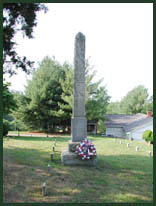 During the Civil War, Scottsville housed a general hospital for the Confederacy. Available
records indicate over 40 Confederate soldiers died in the Scottsville hospital and are buried
nearby at the Confederate Cemetery on Moore's Hill. Today, questions remain about the
identities and exact number of soldiers buried at the Moore's Hill cemetery.
During the Civil War, Scottsville housed a general hospital for the Confederacy. Available
records indicate over 40 Confederate soldiers died in the Scottsville hospital and are buried
nearby at the Confederate Cemetery on Moore's Hill. Today, questions remain about the
identities and exact number of soldiers buried at the Moore's Hill cemetery.For the full feature article by Richard L. Nicholas, visit Hospital. Copyright � 2018 by Scottsville Museum |
||
| John Everett Dickerson, Englishman in the 19th VA Infantry | ||
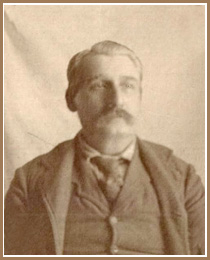 Date: ca. 1890
Date: ca. 1890Image Number: SDT01cdSDT01 Shown at left is John Dickerson, Co. C, 19th VA Infantry. John was an Englishman in Scottsville when the Civil War broke out in Virginia in April 1861. John enlisted in Company C where he served 15 months before being discharged on 16 July 1862 by reason of his being a 'Foreigner and having served out his time of enlistment. John Dickerson then moved to Tennessee and reenlisted in the Confederate Army by joining Company F, 12nd Battalion of the Tennessee Cavalry, in 1863 where he served as an orderly. John's company was serving in eastern Tennessee in 1865 when they were ordered to reinforce General Lee in Virginia. Enroute to help Lee, Co. E. learned of Lee's surrender to the Union Army, and the 12th Battalion, Tennessee Cavalry, then surrendered to Union General Thomas at Knoxville in April 1865. The conquered Confederates were given free transportation to any point in the North that they might choose. John chose Iowa where his father, Samuel, lived. For more information on John Dickerson's Civil War service, visit John Everett Dickerson. Copyright � 2018 by Scottsville Museum |
||
| George Walker Gilmer, 2nd Virginia Cavalry and Mosby's Rangers | ||
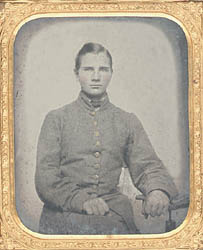 Date: June 16,1863
Date: June 16,1863Image Number: PM01cdPM01 Comments: George Walker Gilmer volunteered as a Private in Company C, 2nd Virginia Cavalry on June 16, 1863. As was often the custom of those war days, George had his photograph taken on the day he joined the Confederate Army. George was twice severely wounded and lost an eye at Gettysburg. His commanding officer, Colonel Thomas T. Mumford, noted that George was distinguished for gallantry and devotion to duty. Copyright � 2018 by Scottsville Museum |
||
| Zachariah Fleming Jones, Mosby's Ranger | ||
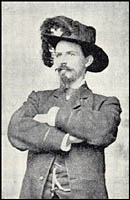 Date: ca. 1864
Date: ca. 1864Image Number: JW01cdJW01 Comments: Zachariah Fleming Jones enlisted in Company D, 43rd Battalion Virginia Cavalry, Mosby's Command in 1864 at the age of seventeen. He was a dashing figure in his Confederate uniform, and in later years, Zack often spoke of the daring exploits and narrow escapes of Mosby and his men. Mosby's Rangers included some of the best horsemen in the country, who frequently traveled by night on raids about the countryside. Again and again, Zack's horses were wounded under him. During a March 1865 battle at Leesburg, Virginia, Jones narrowly escaped death when his horse reared up and took the bullet intended for his rider. Zachariah Jones was paroled at Columbia, Virginia, at war's end and spent the rest of his life in Scottsville. Copyright � 2018 by Scottsville Museum |
||
| Dr. Powhatan Bledsoe, 32nd Virginia Regiment | ||
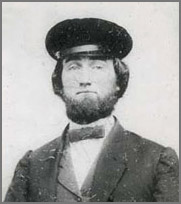 Date: ca. 1861
Date: ca. 1861Image Number: DPB01cdDPB01 Comments: Powhatan Bledsoe was born in Fluvanna County, VA, in 1832, and graduated from the University of Virginia Medical School as a medical doctor in 1858. When the Civil War broke out in early 1861, Dr. Bledsoe was living in Henrico County, VA. His record as an assistant surgeon in the C.S.A. began that spring when he passed his examination before the Army Medical Board in Richmond, VA. In 1908, Dr. Bledsoe recorded the highlights of his CSA medical career to support the membership application of his niece, Mary E. Beal of Scottsville, to the United Daughters of the Confederacy in Virginia. To learn more about Dr. Bledsoe's service as an assistant surgeon in the CSA and in his own words, visit Dr. Powhatan Bledsone. Copyright � 2018 by Scottsville Museum |
||
| War Comes to Scottsville | ||
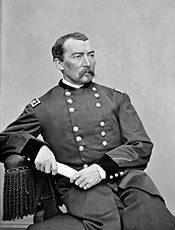 2015 marked the 150th anniversary of one of the most important events in the history of Scottsville since its official
founding in 1818. It was during the week of March 6-10, 1865, that Scottsville was occupied by Union soldiers under the
command of Civil War General Philip H. Sheridan. While the event was of little significance within the context of the
overall Civil War, it had an enormous, enduring, and very personal impact on the people of Scottsville and the neighboring
countryside that were caught in the path of ten thousand marauding Yankee cavalrymen. What follows is a summation of
that historic tragedy with emphasis on some of the people in our community who were directly affected.
2015 marked the 150th anniversary of one of the most important events in the history of Scottsville since its official
founding in 1818. It was during the week of March 6-10, 1865, that Scottsville was occupied by Union soldiers under the
command of Civil War General Philip H. Sheridan. While the event was of little significance within the context of the
overall Civil War, it had an enormous, enduring, and very personal impact on the people of Scottsville and the neighboring
countryside that were caught in the path of ten thousand marauding Yankee cavalrymen. What follows is a summation of
that historic tragedy with emphasis on some of the people in our community who were directly affected.For the full feature article by Richard L. Nicholas, visit War Comes To Scottsville. Copyright � 2018 by Scottsville Museum |
||
| The Yankees Ride Into Scottsville, March 1865 | ||
 Date: March 1865
Date: March 1865Image Number: BurgessRollTwoNeg22A Comments: One fact both Northerners and Southerners could agree upon in early March 1865 was that "the roads were awful, and the weather exceedingly bad," as Judy Egberd of Chralottesville wrote to her daughter in Greensboro. With "no railroad communication now in any direction, and no mails from anywhere, "she said she was sending this undated letter by a friend to Lynchburg for mailing (Mary Rawlings, "Sheridan's Raid Through Albemarle," Magazine of Albemarle County History, 1954). For the full feature article by Ruth Klippstein, visit The Yankees Ride Into Scottsville. Copyright � 2020 by Scottsville Museum |
||
| Jacob Luther Moon, Mosby's Rangers | ||
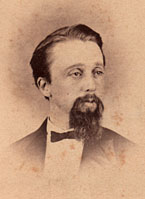 Date: ca. 1880
Date: ca. 1880Image Number: CRMS05cdCRMS01 Comments: In 09 August 1860, Jacob Luther Moon entered the Virginia Military Institute (VMI) as a member of the class of 1864. He was sent to Charlottesville to act as a Drill Master for the Corps of VMI Cadets and to train new recruits. He soon tired of that assignment and wished for active duty. At an unknown date after the Civil War broke out in 1861, Jacob enlisted as a Private in Mosby's Rangers. Pint-sized Jacob proved to be one of the more memorable Rangers. Copyright � 2018 by Scottsville Museum |
||
| James Nelson Moon, Mosby's Rangers | ||
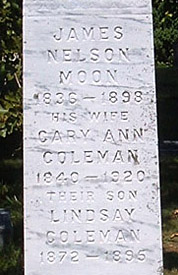 Date: 1836-1898
Date: 1836-1898Image Number: 275MoonJamesNelson Comments: On 17 April 1861, James Nelson Moon enlisted at Scottsville in Company C, 19th Regiment Virginia Infantry. He was discharged on 30 May 1862 due to ill health caused by a wound and after furnishing a substitute to replace him. After recovering from his wound, James volunteered in the 43rd Battalion, Virginia Cavalry (Mosby's Rangers) and served with his younger brother, Jacob Luther Moon. Because of their bravery, James and Jacob were called 'The Dare-Devil Moons' when in Mosby's command. Copyright � 2018 by Scottsville Museum |
||
| Joseph Nicholas Graham, 46th Virginia Infantry | ||
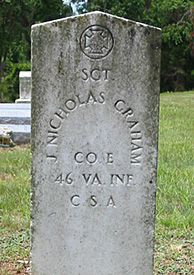 Date: December 10, 1932
Date: December 10, 1932Image Number: CG086cdCG2006GrahamJNicholas Comments: At the age of 16 years, Joseph Nicholas Graham enlisted as a Private in Company E, 46th Virginia Infantry, in Scottsville on June 5, 1861. He was promoted to Sergeant on December 26, 1863. On May 7, 1864, the 46th VA Infantry arrived in Petersburg, VA, after 7.5 months in South Carolina. Their mission was to put extreme pressure on the advancing Army of the Potomac. Though the 46th had endured its share of hardship in three years of war, it had yet suffered but few casualties. Gone were the endless weeks and month of guard duty, camp life, and being held in reserve. By May 17th, the 46th was entrenched near Bake House Creek where it received its first tastes of trench warfare as they became engaged in fierce sharpshooting battles and heavy shellfire with its Union enemy. To learn more about the 46th Virginia Infantry's role at Petersburg in 1864, click on the Joseph's gravestone photo at left above. Copyright � 2018 by Scottsville Museum |
||
| Andrew Mahoney, 19th Virginia Infantry | ||
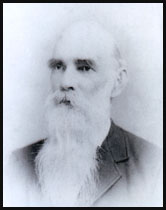 Date: ca. 1890
Date: ca. 1890Image Number: PW03cdPW01 Comments: When the War Between the States broke out in April 1861, Andrew Mahoney was a 35-year old carpenter for the James River and Kanawha Canal and the father of five children under the age of eleven. He enrolled for active service as a Sergeant in Company C (Scottsville Guard), 19th Virginia Infantry on April 17th, 1861. Andrew was elected to Captain of Company C on November 6, 1861, and served in that capacity until 28 April 1862 when he retired. Andrew later appeared on the roll of POWs paroled at Columbia, Virginia. Copyright � 2018 by Scottsville Museum |
||
| Joseph Russell Beal, Mosby's Rangers | ||
 Date: ca. 1890
Date: ca. 1890Image Number: JJW03cdJJW01 Comments: Private Joseph R. Beal served with Mosby's Rangers, 43rd Virginia Cavalry, Company D. Joseph was born in Scottsville, VA, on 5 May 1847, and was the son of Joseph Russell and Mary Elizabeth (Flanagan) Beale. Joseph's older brother, John D. Beal, also served with Company D under the direct command of Captain R. P. Montjoy. Copyright � 2018 by Scottsville Museum |
||
| Jonathan Pitts, 19th Virginia Infantry | ||
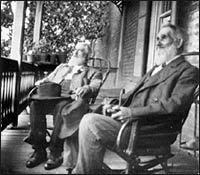 Date: ca. 1905
Date: ca. 1905Image Number: M48acdKM03 Comments: In this circa 1905 photo, Jonathan Pitts sat with an old Civil War friend on the back porch of his home on Main Street. On April 17, 1861, Virginia seceded from the Union, and Jonathan joined the Scottsville Guard, a local militia unit destined to become Company C, 19th Virginia Infantry. Jonathan was thirty-eight years old. He served in the 19th VA until he was discharged on July 16, 1862, because his term of service expired and he was over forty years old. Copyright � 2018 by Scottsville Museum |
||
| Colonel Henry Gantt of Valmont, 19th Virginia Infantry | ||
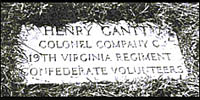 Date: 1884
Date: 1884Image Number: RN01cdRN01 Comments: Colonel Henry Gantt commanded Co. C, 19th Virginia Infantry, that entered the Civil War on April 17, 1861. Gantt was severely wounded at Cemetery Ridge during the battle of Gettysburg. After Appomatox, he returned to his Valmont home in Scottsville. Copyright � 2018 by Scottsville Museum |
||
| Oswin Smith Harris, Post Quartermaster Department, Captain Thomas Wood, VA | ||
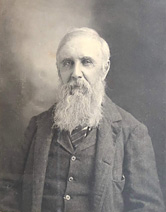 Date: ca. 1900
Date: ca. 1900Image Number: RT01cdRT01 Comments: Oswin Smith Harris entered the Civil War in 1862 and served for Virginia in the Post Quartermaster Department, Captain Thomas Wood, Charlottesville. During the War, Oswin suffered a gunshot wound to his arm, but he continued his Civil War service for VA until Virginia surrendered and the War ended in Spring 1865. in April 1865. By March 1904, Oswin was suffering from nervous paralysis in his arm and could no longer personally earn a living for himself, and he submitted an Application of Soldier for Disability to the State of Virginia on March 16, 1904, at the age of 69 years. Copyright � 2022 by Scottsville Museum |
||
| Lieutenant Patrick William Bruffy, 31st Virginia Infantry | ||
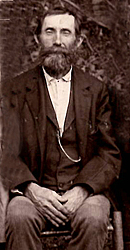 Date: ca. 1902
Date: ca. 1902Image Number: PWB01cdPWB01 Comments: Patrick William Bruffy was born in 1840 in Bath, Virginia. He enlisted in the 31st Virginia Infantry on June 15, 1861 at Laurel, Virginia, and was wounded on Dec. 13, 1861, at the Battle of Camp Allegheny in Pocahontas Co., VA (now WVA). Patrick was reported sick with typhoid fever at the Confederate Hospital at Mt. Jackson, VA, in June 1862. When he had recovered from his illness, Patrick was appointed 2nd Lieutenant of Co. I, 31st Virginia Infantry, in August 1862 and was wounded at Manassas later that month. After the Civil War, Patrick farmed in Ritchie County, VA, and in Lewis county, WVA. He moved with his family to Scottsville District, VA, after 1900 and worked as a farmer there with his family until he passed away from tuberculosis on Dec. 3, 1918. Patrick William Bruffy is buried at Scottsville Cemetery. For more information about Patrick Bruffy's Civil War service and his family, visit Patrick William Bruffy.. Copyright � 2020 by Scottsville Museum |
||
| Thomas H. Childress, 1907 | ||
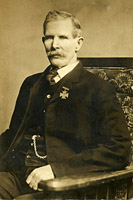 Date: 1907
Date: 1907Image Number: DRT01cdDRT01 Comments: Thomas H. Childress was born May 4, 1840, at 'Seven Oaks' near Esmont, VA. He was the son of Robert M. and Lucy Overton Childress, a couple of some means in Albemarle County, VA. When the Civil War came, the 20 yr. old Thomas wasted no time in enlisting in Capt. Albert Gantt's company of Virginia volunteers called the 'Scottsville Guard." Eventually this company would form Company C, 19th Virginia Infantry. On 5 July 1863, Thomas transferred to the 15th Virginia Cavalry. Thomas was paroled on 21 May 1865 and returned to Ablemarle County, VA, where he later became a justice of the peace. Copyright � 2018 by Scottsville Museum |
||
| Confederate Veteran Reunion at Buckingham Courthouse, 1908 | ||
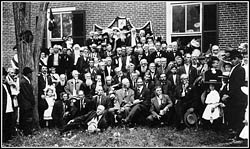 Date: 1908
Date: 1908Image Number: B40cdB15 Comments: The 1908 Reunion of Confederate Veterans at Buckingham Courthouse drew soldiers and their families from Buckingham County, Albemarle County, and the surrounding area. See larger image for a partial list of reunion attendees plus the identities of Scottsville area soldiers. Copyright � 2018 by Scottsville Museum |
||
| Confederate Veteran Reunion, 1908 | ||
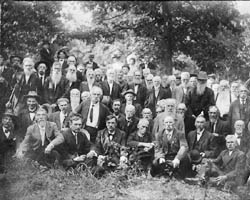 Date: July 21, 1908
Date: July 21, 1908Image Number: RollTwoNeg16 Comments: The 1908 Reunion of Confederate Veterans in Scottsville drew 128 soldiers from the Virginia counties of Albemarle, Buckingham, Fluvanna, and Nelson. See larger image for identities of some reunion attendees from the Scottsville area. Copyright � 2018 by Scottsville Museum |
||
| Confederate Reunion Dinner Committee, 1908 | ||
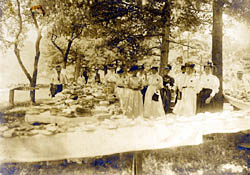 Date: July 21, 1908
Date: July 21, 1908Image Number: B80cdB17 Comments: The Confederate Reunion Dinner Committee, consisting of 40 ladies led by Mrs. W. D. Patteson and Chairman Samuel R. Gault,served a bountiful feast to the 128 veterans and a hungry crowd of over 2000 spectators. More than 300 food baskets were donated for the dinner, some of which can be seen on the food-laden tables in this photo. Copyright � 2018 by Scottsville Museum |
||
| Confederate Reunion, 1908 | ||
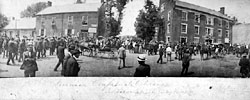 Date: July 21, 1908
Date: July 21, 1908Image Number: B06cdB18 Comments: A Grand Rally and Reunion of Confederate veterans was held at Scottsville on July 21, 1908. This Burgess panorama was taken on Valley Street, looking west at the intersection of West Main and Valley Street, and shows some of the over 2000 people who gathered to greet the veterans. See larger image for the identities of these buildings. Copyright � 2018 by Scottsville Museum |
||
| Crowds at the Confederate Reunion, 1908 | ||
 Date: July 21, 1908
Date: July 21, 1908Image Number: RollTwoNeg1 Comments: Over 2000 spectators gathered in Scottsville for the 1908 Reunion of Confederate Veterans. Pictured here against a backdrop of south Main Street are some veterans and their friends engaged in eloquent discourse. See larger image for the identities of these buildings. Copyright � 2018 by Scottsville Museum |
||
| George Allen Tapscott, 1922 | ||
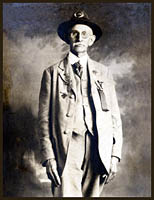 Date: 1922
Date: 1922Image Number: B244bcdB24 Comments: George Allen Tapscott is shown in this 1922 photo taken at a Confederate reunion in Richmond, Virginia. Born in Buckingham County, Virginia, in 1850, George enlisted in Company D, 56 Virginia at the age of 15 years. He served first at Chaffin's Farm near Richmond and later at Cold Harbor where his health was broken. George left service after Cold Harbor and returned to Scottsville. Copyright � 2018 by Scottsville Museum |
||
| Peter Johnston White III, 1924 | ||
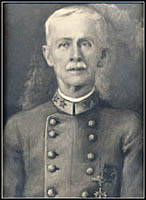 Date: 1924
Date: 1924Image Number: WW01cdWW01 Comments: Peter Johnston White is shown in his uniform as commander of the R.E. Lee Camp of Confederate Veterans, Richmond. He posed for this painting on the occasion of his golden wedding anniversary on December 12, 1924. Despite his youthful age of 14 years, Peter enlisted in Company G, 5th Virginia Cavalry on July 24, 1864, and participated in numerous engagements with Fitzhugh Lee's cavalry. After the war, Peter returned to Scottsville and later lived at Red Hills in Fluvanna County, Virginia. Copyright � 2018 by Scottsville Museum |
||
|
Museum
Archive
Business
Cemeteries
Church
Events
Floods
For Kids
Homes
Portraits
Postcards
School
Transportation
Civil War
WWII Esmont Search Policy |
||||
| Scottsville Museum · 290 Main Street · Scottsville, Virginia 24590 · 434-286-2247 | ||||
|
www.avenue.org/smuseum · info@scottsvillemuseum.com Copyright © 2022 by Scottsville Museum |
||||